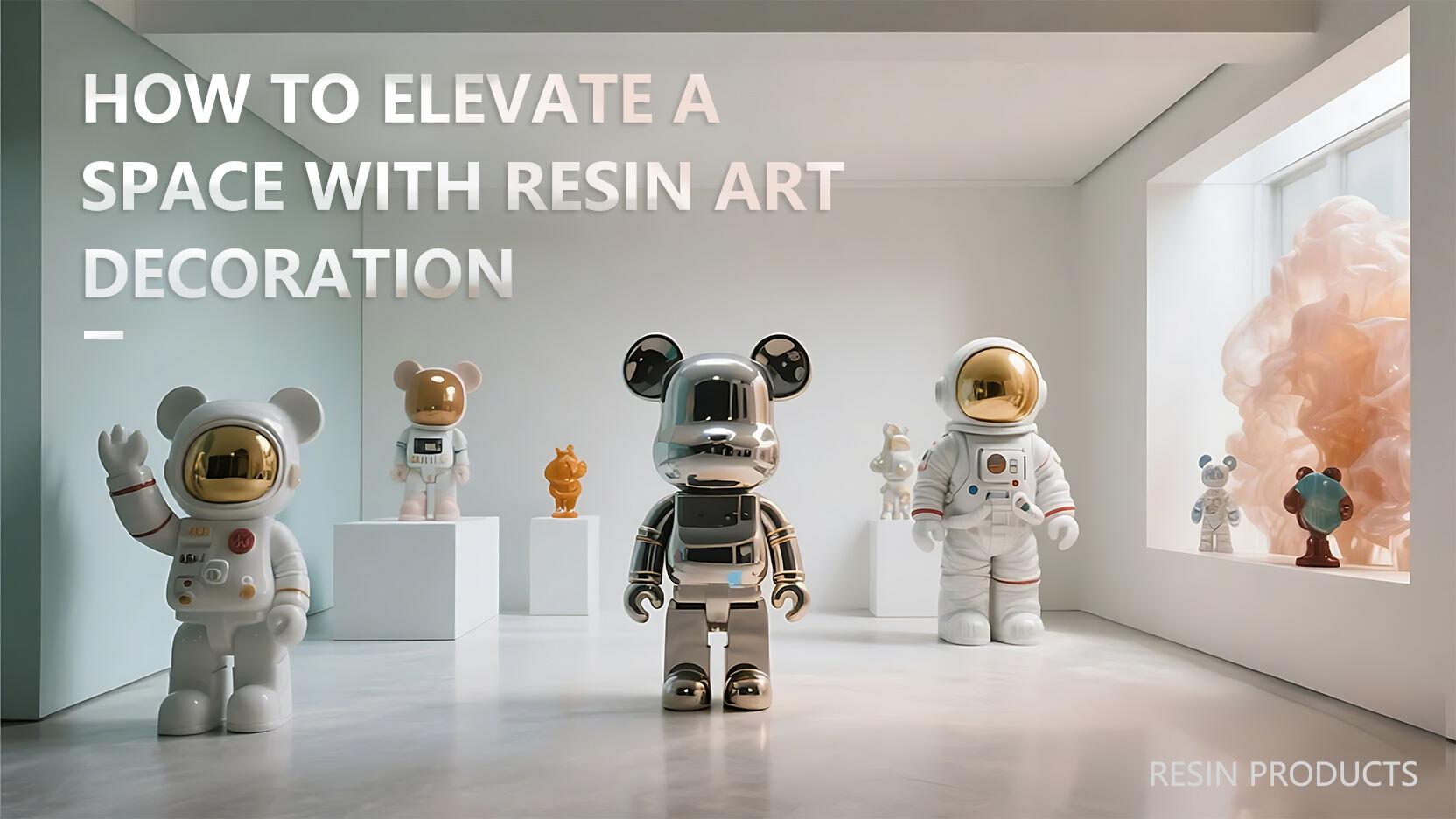ຄວາມນິຍົມທີ່ເພີ່ມຂື້ນຂອງສິນລະປະດ້ວຍມື Resin ໃນການຕົກແຕ່ງເຮືອນ
ການຫຼິ້ນກັບ Resin ກຳລັງປ່ຽນແປງພື້ນທີ່ໃນເຮືອນໃນທຸກມື້ນີ້ດ້ວຍຄວາມຫຼາກຫຼາຍ ແລະ ຜົນກະທົບທາງທັດສະນະທີ່ບໍ່ເຄີຍມີມາກ່ອນ. ພ້ອມໂປລີເມີທີ່ສັງເຄາະຂຶ້ນນີ້ສາມາດຂຶ້ນຮູບໄດ້ທຸກຢ່າງຕັ້ງແຕ່ເຄື່ອງປະດັບທີ່ລະອຽດອ່ອນຈົນເຖິງເຟີນີເຈີທີ່ມີຄວາມກ້າຫຼາຍເຊັ່ນໂຕະແບບແມ່ນ້ຳ, ປິດຜິວດ້ວຍສີ ແລະ ວັດຖຸທີ່ຖືກຝັງໄວ້ພາຍໃນດ້ວຍຄວາມໂປ່ງໃສຄືກັບນ້ຳ. ດ້ວຍການເຕີບໂຕຂອງການຕົກແຕ່ງເຮືອນທີ່ສາມາດປັບແຕ່ງໄດ້ຕາມໃຈຜູ້ໃຊ້, Resin ໃຫ້ຄວາມສາມາດແກ່ຜູ້ສ້າງສັນເພື່ອຜະລິດເຄື່ອງປະດັບທີ່ສວຍງາມ ແລະ ມີປະໂຫຍດ—ເຊັ່ນແຜ່ນຮອງຖ້ວຍທີ່ຄືກັບຮູບແຕ້ມຂະໜາດນ້ອຍ, ແຜ່ນຮອງຖ້ວຍທີ່ມີແສງຫຼັງທີ່ຄືກັບທ້ອງຟ້າຕອນກາງຄືນ, ຫຼື ຊິ້ນງານທີ່ເປັນມິດກັບສິ່ງແວດລ້ອມທີ່ເຮັດຈາກໄມ້ທີ່ເກັບມາໄດ້.
ຄວາມອົດທົນຂອງສື່ກາງເຮັດໃຫ້ມັນເປັນທີ່ນິຍົມ, ເນື່ອງຈາກພື້ນໂປຼເລັນສາມາດຢູ່ໄດ້ດົນຈົນເຖິງໄວຜູ້ໃຫຍ່ຂອງລູກທ່ານ, ສາມາດຕ້ານທານຕໍ່ການຂີດຂ້າງແລະການຫກລົ້ນໃນຂະນະທີ່ຄອບຄົວຂອງທ່ານເຕີບໂຕຂຶ້ນ. ຄວາມສອດຄ່ອງທາງສິ່ງແວດລ້ອມສາມາດເກີດຂຶ້ນຜ່ານການປະສົມທີ່ມີສ່ວນປະກອບທີ່ຮີໄຊເຄີນ, ສອດຄ່ອງກັບຄວາມປາຖະໜາໃນການຮັກສາສິ່ງແວດລ້ອມໃນປີ 2025. ໃນແງ່ມຸມໃໝ່ຂອງແນວໂນ້ມທີ່ດົນນານ, ສື່ສັງຄົມກຳລັງຂັບເຄື່ອນຄວາມຕ້ອງການ, ດ້ວຍວິດີໂອເຊິ່ງກະຈາຍຢ່າງໄວວາກ່ຽວກັບການເທ resin ທີ່ດຶງດູດຜູ້ຊົມດ້ວຍວິທີການທີ່ເຮັດໃຫ້ຄົນລຸ້ນໃໝ່ຕື່ນເຕັ້ນ. ການປະສົມປະສານກັນຂອງການອອກແບບ, ຄວາມອົດທົນ, ແລະການປັບແຕ່ງເຮັດໃຫ້ງານສິລະປະດ້ວຍ resin ເປັນສິ່ງສຳຄັນໃນການອອກແບບທີ່ຢູ່ອາໄສໃນປັດຈຸບັນ.
ວິທີການສຳຄັນໃນງານສິລະປະດ້ວຍ Resin ເພື່ອຜົນໄດ້ຮັບທີ່ສວຍງາມ
ການເຂົ້າໃຈວິທີການພື້ນຖານຂອງ Resin ສາມາດປ່ຽນໂປຼເລັນທຳມະດາໃຫ້ກາຍເປັນວັດຖຸສະແດງທີ່ສວຍງາມ. ຂໍ້ມູນໃນປັດຈຸບັນສະແດງໃຫ້ເຫັນວ່າຫຼາຍກວ່າ 92% ຂອງຊ່າງສິລະປິນໃຫ້ຄວາມສຳຄັນກັບວິທີການຫຼາຍກ່ວາວັດສະດຸເພື່ອຜົນໄດ້ຮັບທີ່ພ້ອມສຳລັບການຈັດແສດງ. ວິທີການຕົ້ນຕໍຕ້ອງສົມດຸນລະຫວ່າງຄວາມແທດເຈາະຈົງທາງເຄມີກັບການທົດລອງແບບສິລະປະເພື່ອຜະລິດເນື້ອເພື້ອທີ່ສະເພາະແລະເປັນເອກະລັກ.
ວິທີການຊັ້ນແລະການΩັກລົງ
ສ້າງຄວາມເລິກຂອງມິຕິໂດຍການເທ resin ໃນຂັ້ນຕອນຕ່າງໆຢ່າງຕໍ່ເນື່ອງ ແລະ ການບູຮະນະລັງຫຼັງຈາກແຕ່ລະຄັ້ງ. ການຊັ້ນຫຼາຍຊັ້ນອະນຸຍາດໃຫ້ການຈັດວາງພືດ, ທາດໂລຫະ ຫຼື ຕົວຢ່າງເຄື່ອງເຮັດໃຫ້ເກີດຂຶ້ນຢ່າງຕັ້ງໃຈ. ການຍົກເລີກແບບຍຸດທະສາດສ້າງເລື່ອງລາວ 3D ໃນຕົວແບບໂພລີເມີ່ທີ່ໂປ່ງໃສ.
ຄວາມລັບໃນການຄົມສີ Alcohol Ink
ບັນລຸຜົນກະທົບນ້ຳມັນສີໂດຍການຊັ້ນສີທີ່ແປງເປັນອິນຊັ້ນທີ່ເຮັດມາຈາກນ້ຳຢານໃສ່ resin ທີ່ຍັງບໍ່ແຫ້ງ. ການຄວບຄຸມຄວາມຫນາແຫນ້ນເພື່ອໃຫ້ໄດ້ຮູບແບບ "cells" - ຮູບແບບວົງມົນທີ່ເກີດຂຶ້ນຜ່ານການຄວບຄຸມຄວາມຕຶງຜິວໜັງ. ການປ່ຽນສີທີ່ມີລາຍລຽນໂດຍໃຊ້ອິນຊັ້ນເຫຼົ່ານີ້ສະແດງໃຫ້ເຫັນການມີສ່ວນຮ່ວມຂອງຜູ້ຊົມຫຼາຍຂຶ້ນ 4 ເທົ່າກ່ວາການເທສີດຽວ.
ສີພິເສດ ແລະ ຜົນເຮັດໃຫ້ເຫັນແສງ
ລວມເອົາຜົງທີ່ສາມາດດູດຊືມແສງ ຫຼື ສ່ວນປະສົມທີ່ປ່ຽນສີຕາມແສງສະຫວ່າງ/ອຸນຫະພູມ. ສ່ວນປະກອບ mica ເຮັດໃຫ້ແສງສະຫວ່າງແບ່ງຕົວເພື່ອສ້າງພື້ນຜິວທີ່ປ່ຽນສີໄດ້. ສ່ວນປະກອບທີ່ມີການຕອບສະໜອງເຫຼົ່ານີ້ຍົກລະດັບການໃຊ້ງານ, ດ້ວຍຊິ້ນສ່ວນ resin ທີ່ສາມາດເຫັນແສງໄດ້ຮັບຄວາມນິຍົມເພີ່ມຂຶ້ນ 140% ໃນພື້ນທີ່ມືດ.
ວິທີການປັບແຕ່ງເພື່ອໃຫ້ໄດ້ຮູບແບບທີ່ເປັນເອກະລັກ
ການສະເພາະບຸກຄົນເຮັດວຽກຜ່ານທາງແບບໂຊລິເຄີນ, ການຄວບຄຸມຄວາມຮ້ອນ, ຫຼື ວັດຖຸດິບປະເພດຕ່າງໆເຊັ່ນດອກໄມ້ແຫ້ງ. ການປະສົມປະສານລະຫວ່າງອົງປະກອບຂອງພື້ນຜິວກັບເທັກນິກສີໃຫ້ຮູບແບບທີ່ເປັນເອກະລັກ - 78% ຂອງຜົນງານທີ່ສັ່ງເຮັດໃນປີ 2023 ມີແນວໂນ້ມສ່ວນຕົວ ຫຼື ສິ່ງຂອງທີ່ຖືກຝັງເພື່ອເຮັດໃຫ້ເກີດຄວາມຮູ້ສຶກ.
ການປັບປຸງເຟີນີເຈີແບບເຮຊິນ: ໂຕະ ແລະ ໜ້າເຄົາເຕີ
ການປັບປຸງເຟີນີເຈີແບບເຮຊິນປະສົມເອົາການສະແດງອອກທາງສິລະປະກັບການອອກແບບທີ່ໃຊ້ງານໄດ້, ສະເໜີພື້ນຜິວທີ່ມີຄວາມທົນທານຊ່ວຍຍົກລະດັບພາຍໃນ. ເຮຊິນອີໂພຊິກມີຄວາມຫຼາກຫຼາຍຊ່ວຍໃຫ້ປະສົມສີ, ພື້ນຜິວ, ແລະ ວັດຖຸດິບຕ່າງໆໄດ້ຢ່າງລຽບລຽນ, ເຮັດໃຫ້ມັນເໝາະສຳລັບການຜະລິດຜົນງານທີ່ເປັນຈຸດສົນທະນາ.
ຊັ້ນຜິວເຮຊິນອີໂພຊິກທີ່ທົນທານ
ສີອີໂພຊິກໃນມື້ນີ້ ສະເໜີຄວາມສົມດຸນທີ່ດີລະຫວ່າງຄວາມທົນທານແບບອຸດສາຫະກຳ ແລະ ຄວາມງາມແບບຫັດຖະກຳ, ດັ່ງນັ້ນຈຶ່ງເປັນທາງເລືອກທີ່ດີທີ່ສຸດສຳລັບພື້ນຜິວທີ່ຕ້ອງໃຊ້ງານປະຈຳວັນ ແຕ່ຍັງຕ້ອງການຮັກສາຄວາມງາມໄວ້. ສີອີໂພຊິກເຫຼົ່ານີ້ສາມາດຕ້ານທານອຸນຫະພູມໄດ້ສູງເຖິງ 150 ອົງສາແຟຣນໄຮ (Fahrenheit) ແລະ ມີຄວາມສະຖຽນລະພາບຕໍ່ແສງ UV ສຳລັບການໃຊ້ງານພາຍນອກ, ພ້ອມທັງຕ້ານການຂູດຂີດໄດ້ດີກ່ວາ laminate ທຳມະດາ ຕາມການທົດສອບຈາກວິທີການທົດສອບຄວາມຕ້ານທານຂອງ Laminate scratch test method ໃນບົດລາຍງານວັດສະດຸເຟີນີເຈີ 2025. Epoxy resin ລະດັບພິເສດແມ່ນມີຄວາມສາມາດໃນການຕົບແຕ່ງພື້ນຜິວດ້ວຍຕົນເອງ ດັ່ງນັ້ນຈຶ່ງບໍ່ມີຮ່ອງຮອຍຂອງແປງສີ, ແລະ ພື້ນໂຕະທີ່ເງົາເປັນແກ້ວກໍ່ເກືອບສາມາດເຮັດຄວາມສະອາດດ້ວຍຕົນເອງ. ບັນດາເຈົ້າຂອງເຮືອນຫຼາຍກ່ວາ 60% ທີ່ປັບປຸງໂຄງສ້າງເຮືອນຄົວໃໝ່ ປັດຈຸບັນນິຍົມໃຊ້ພື້ນຜິວ resin ເຊິ່ງຕິດຕັ້ງງ່າຍຂຶ້ນ ແລະ ມີຄ່າໃຊ້ຈ່າຍຕໍ່າກ່ວາການນຳໃຊ້ຫີນ.
ກໍລະນີສຶກສາ: River Table Designs
ຕัวຢ່າງທີ່ດີເດັ່ນ ແລະ ຫຼື ສຳຄັນ: ປະເພດຂອງເຮຊິນ, ແຂບໂຕະແມ່ນນ້ຳ - ແຂບໂຕະແມ່ນນ້ຳປະສົມຊິ້ນໄມ້ທີ່ຖືກຮັກສາໄວ້ກັບເຣຊິນ epoxy ເພື່ອເຮັດໃຫ້ຄືກັບບ່ອນທີ່ນ້ຳໄຫຼເຂົ້າກັນຢ່າງເປັນທຳມະຊາດ, ນີ້ເປັນການນຳໃຊ້ເຣຊິນທີ່ມີຄວາມຄິດສ້າງສັນ. ການຄົ້ນຄວ້າໃໝ່ພົບວ່າຜູ້ຊື້ເຟอร์ນີເຈີແບບສັ່ງຕາມຄວາມຕ້ອງການ ມັກຊື້ບັນດາຊິ້ນງານທີ່ປະສົມລະຫວ່າງເນື້ອຜ້າທຳມະຊາດກັບວັດສະດຸທີ່ທັນສະໄໝ. ສ່ວນໃຫຍ່ຂອງຊິ້ນງານເຫຼົ່ານີ້ຖືກສ້າງຈາກໄມ້ທີ່ຟື້ນຟູຄືນແລ້ວ ແລະ ເຣຊິນທີ່ບໍ່ເປັນພິດ, ບາງອັນມີແສງສະຫວ່າງ LED ຢູ່ດ້ານລຸ່ມຊັ້ນເຣຊິນ epoxy ເພື່ອໃຫ້ມີອາລົມແບບອົບອຸ່ນ. ແຂບໂຕະແມ່ນນ້ຳຂະໜາດໃຫຍ່ໃຊ້ເວລາປະມານ 3-6 ອາທິດໃນການຜະລິດ, ເຊິ່ງໃຫ້ເວລາພຽງພໍໃນການສັງເກດລາຍລະອຽດຂອງສີທີ່ປ່ຽນແປງ ແລະ ການວາງໄມ້.
ສິນລະປະເຣຊິນທີ່ໃຊ້ງານໄດ້: ແຜ່ນປ້ອງກັນນ້ຳ ແລະ ພາຊະນະ
ຕູ້ເຮັດດ້ວຍຊິນແປງທີ່ມີສິນລະປະທີ່ທັນສະໄໝເພື່ອປົກປ້ອງພື້ນຜິວ ແລະ ຍົກລະດັບພື້ນທີ່ໃດກໍ່ຕາມ. ໂຖດັກກະຈອຍທີ່ເຂົ້າມຸມຫ້ອງເໝາະສຳລັບການຈັດການກຸນແຈ ແລະ ຈົດໝາຍຢູ່ບ່ອນທີ່ຄົນຜ່ານໄປມາຫຼາຍຍ້ອນມີໂຄງສ້າງເຫຼັກທີ່ຖືກປົກຫຸ້ມດ້ວຍເຣຊິນທີ່ຕ້ານການຂູດຂີດໄດ້ດີ. ໂຖໃຊ້ໃນການບໍລິການຊຸດດຽວກັນດ້ວຍການຝັງພຶກສາທຳມະຊາດ ຫຼື ລາຍເສັ້ນແບບທະເລທີ່ຮັກສາຮູບຮ່າງໄວ້ໄດ້ດີ. ຮູບແບບເຫຼົ່ານີ້ຍັງດີຕໍ່ສິ່ງແວດລ້ອມອີກດ້ວຍເນື່ອງຈາກມັນສາມາດເເທນທີ່ຂອງທີ່ຖິ້ມຫຼັງໃຊ້ເພື່ອສະພາບແວດລ້ອມທີ່ຍືນຍົງ.
ໂຖດັກກະຈອຍທີ່ເຂົ້າມຸມຫ້ອງ ແລະ ໂຖໃຊ້ໃນການບໍລິການ
ໂຖເຮັດດ້ວຍຊິນແປງຊ່ວຍຍຸດຕິບັນຫານ້ຳຕົກເປື້ອນທີ່ບ່ອນເຂົ້າມຸມຫ້ອງດ້ວຍຮູບແບບທີ່ເຮັດໃຫ້ຄິດເຖິງຫີນອ່ອນ, ຫີນ quartz, ຫຼື ແມ້ກະທັ້ງສິນລະປະແບບດູດສະແຕນ ແລະ ຍັງຄວບຄຸມນ້ຳທີ່ໄຫຼຈາກກະຈົກທີ່ເປື້ອນນ້ຳຝົນອີກດ້ວຍ. ໂຖບໍລິການປະກອບເອົາດອກໄມ້ແຫ້ງ ຫຼື ເປືອກຫອຍແບບທະເລປະສົມກັບຊິນແປງທີ່ໃສເໝືອນຜິງເພື່ອໃຫ້ໄດ້ສິນລະປະທີ່ມີຄວາມຮູ້ສຶກ ແລະ ຄວາມທົນທີ່ສາມາດລ້າງໃນເຄື່ອງໄດ້. ການປັບແຕ່ງສ່ວນຕົວຮັບປະກັນວ່າຊ່ວງເວລາພິເສດເຊັ່ນ: ສິ່ງທີ່ເກັບໄດ້ຈາກດ້ວຍຊາຍ ຫຼື ດອກໄມ້ໃນວັນຄົບຮອບຍັງຄົງເປັນມໍລະດົກທີ່ໃຊ້ງານໄດ້.
ຮູບແບບຕູ້ເຮັດດ້ວຍຊິນແປງທີ່ມີລາຍເສັ້ນແບບເລຂາຄະນິດ
ຕຸກນ້ຳຮູບຫົກແຈ ຫຼື ຮູບສາມແຈທີ່ມີລາຍລະອຽດສີເທົາ-ຂາວ ແລະ ພື້ນຜິວມັນເງົາຊ່ວຍປ້ອງກັນພື້ນໂຕະຈາກເຄື່ອງດື່ມຮ້ອນ ແລະ ຍັງສາມາດເກັບຮັກສາໄວ້ໃນທາງດຽວກັນເພື່ອປະຢັດພື້ນທີ່. ດ້ວຍການລອຍຕົວເສັ້ນໃຍໂລຫະ ຫຼື ຫີນໄຟຟ້າຂະໜາດນ້ອຍໃນເລຊິນ, ຊິ້ນສ່ວນຕົກແຕ່ງເຫຼົ່ານີ້ປະສົມປະສານການຮັກສາໄວ້ກັບສິ່ງຕົກແຕ່ງທີ່ເປັນເອກະລັກ. ຮູບແບບທີ່ທັນສະໄໝເຂົ້າກັນໄດ້ດີກັບການຕົກແຕ່ງແບບມິນິມາລິສ ແລະ ສາມາດໃຊ້ງານປະຈຳວັນໄດ້.
ສິລະປະເລຊິນທີ່ດົນໃຈຈາກທຳມະຊາດ: ຫີນໄຟຟ້າ ແລະ ດອກໄມ້
ສິລະປະເລຊິນເຊື່ອມຕໍ່ຄວາມງາມແບບທຳມະຊາດກັບທັກສະການຜະລິດທີ່ທັນສະໄໝ, ກັບແນວໂນ້ມທີ່ສຳຄັນໃນປີ 2024 ລວມມີຫີນໄຟຟ້າ ແລະ ລາຍດອກໄມ້. ການອອກແບບທີ່ດົນໃຈຈາກທຳມະຊາດເຫຼົ່ານີ້ນຳໃຊ້ຄວາມຫຼາກຫຼາຍຂອງເລຊິນເພື່ອລອກແບບຄວາມເປັນພູມສັນຖານ, ສ່ວນປະກອບພືດ ແລະ ພື້ນຜິວແບບທະເລ, ສະເໜີເປັນສິ່ງເຕີມເຕີມທີ່ມີຄວາມທັນສະໄໝໃຫ້ກັບພື້ນທີ່ພັກອາໄສທີ່ທັນສະໄໝ.
ວິທີການສິລະປະຫີນໄຟຟ້າຕິດຕັ້ງຕາມຝາ
ສິລະປິນໃຊ້ເຮືອນແຜ່ນຢາງທີ່ມີສີດ້ວຍການປົນກັບແກ້ວບົດ, ຜ້າໂລຫະ, ແລະ ສານເພີ່ມທີ່ຄ້າຍກັບແຮ່ທາດເພື່ອສ້າງໂຄງສ້າງຜົນເປັນຜຶກ. ສີທີ່ໃຊ້ຢາງໃນການເຮັດໃຫ້ເບິ່ງເຫັນເຖິງຄວາມເລິກ, ໃນຂະນະທີ່ການວາງວັດສະດຸທີ່ສາມາດສະທ້ອນແສງໄດ້ຢ່າງມີຍຸດທະສາດຊ່ວຍໃນການລອກຄືນແສງທີ່ຫັກເຫຼີ້ມຕາມທໍາມະຊາດ. ສໍາລັບການຕິດຕັ້ງໃນຂະໜາດໃຫຍ່, ຊ່າງງານໃຊ້ແຜ່ນຢາງທີ່ເທລົງແລ້ວແຍກດ້ວຍໄລຍະເວລາການແຫ້ງເພື່ອສ້າງຮູບແບບຂອງ "ຫີນ" ທີ່ມີມິຕິ.
ກະບອກແກ້ວ ແລະ ໂມງທີ່ມີດອກໄມ້ປະດັບຢູ່ພາຍໃນ
ຜູ້ປະດິດສ້າງຮັກສາດອກໄມ້ແຫ້ງອ່ອນໄຫວ ຫຼື ເຟີນໄວ້ພາຍໃນຢາງທີ່ຕ້ານທານ UV, ວາງໃບດອກໄມ້ດ້ວຍມືທີ່ແທ້ທຽງກ່ອນຈະປິດລົງ. ການຈັດແຈງດອກໄມ້ໃນໜ້າປັດຈຸບັນ ຫຼື ກະບອກແກ້ວສ້າງຄວາມສົມດຸນລະຫວ່າງຄວາມເປราะບາງ ແລະ ຄວາມຖາວອນ, ພ້ອມທັງພື້ນຫຼັງທີ່ບໍ່ສາມາດເບິ່ງຜ່ານໄດ້ເພື່ອເນັ້ນຮູບແບບຂອງດອກໄມ້. ການເທຢາງໃນແຜ່ນບາງໆຊ່ວຍປ້ອງກັນຄວາມເສຍຫາຍຈາກຄວາມຮ້ອນ ແລະ ຮັກສາຄວາມສົມບູນຂອງໃບດອກໄມ້ໃນຂະນະທີ່ຢາງແຫ້ງຕົວ.
ອົງປະກອບ ແລະ ພື້ນຜິວທີ່ອອກແບບຕາມແນວຄິດທາງທະເລ
ພູມເນື້ອແບບຄືລວາຍເກີດຈາກເຮຊິນທີ່ຖືກຄວບຄຸມດ້ວຍມີດປາເລດຫຼືເຄື່ອງມືຢາງສິລິໂຄນ ໃນຂະນະທີ່ສ່ວນປະສົມທາດໂຊດຊາຍສ້າງຜິວໜ້າທີ່ແຫ້ງແກ່ນຄືແຄມທະເລ. ເຕັກນິກການລາຍນ້ຳມັນສີທີ່ໃຊ້ເອກໂຮລ໌ (Alcohol ink marbling) ສ້າງຜົນໄດ້ຄືນ້ຳຕາມແບບນ້ຳສີນ້ຳຕາມທີ່ໄຫຼລົງ, ພ້ອມກັບສ່ວນປະກອບຂອງແກ່ນຫອຍທີ່ຖືກຝັງເຂົ້າໄປ. ສີເຂົ້າ-ຂຽວຂອງເຮຊິນທີ່ຊັ້ນກັນດ້ວຍສີຂາວແຈ່ງແຍງ ສະທ້ອນໃຫ້ເຫັນເຖິງຄວາມຮ້ອນແຮງຂອງຄື້ນຟອງແລະການຫັກເຫັນແສງຕາເວັນ.
ການຕີຄວາມໝາຍທີ່ດຶງດູດຈາກທຳມະຊາດ
ວິທີການທົດລອງໃຊ້ເຮຊິນເທລົງໄປໃນຮູບແບບອິດສະລະເພື່ອລະນຶກເຖິງທັດສະນະທາງທຳມະຊາດ ໂດຍມີການหยດລົງຂອງນ້ຳມັນສີທີ່ສະແດງເຖິງປ່າໄມ້ ຫຼື ຕອນເຂົາ. ເຕັກນິກທີ່ໃຊ້ການເປ່າດ້ວຍເຄື່ອງເປົ່າຮ້ອນ (Heat gun) ສ້າງຮູບແບບໂຄງສ້າງທີ່ເບິ່ງຄືຊີວິດຄືເຊື້ອເຫັດ ຫຼື ທ້ອງຟ້າໃນວັນທີ່ມີພายຸ. ສີທີ່ເປັນທຳມະຊາດແລະອ່ອນໂຍນເປັນສີຫຼັກ ແຕ່ສີສັນທີ່ແຈ່ມແຈ້ງເຊັ່ນ: ສີຄຳແບບໂລຫະຈະເພີ່ມຄວາມທັນສະໄໝໃນການປະສົມທີ່ມີຄວາມເປັນທຳມະຊາດ.
ການຈັດວາງຜະລິດຕະພັນເຮຊິນໃນທາງຍຸດທະສາດເພື່ອໃຫ້ໄດ້ຜົນກະທົບສູງສຸດ
ຄູ່ມືເລືອກເຟີນີເຈີທີ່ເປັນຈຸດສຳຄັນຂອງພື້ນທີ່
ຖ້າເກີບເຊັ່ນຕະຫຼອດຕູ້ເຄື່ອງປູນຢາງສິນລະປະ ຄືກັບໂຕະກາເຟ ຫຼື ໂຕະວາງທີວີ ສາມາດເວົ້າໄດ້ (ແລະມັນຈະເປັນສິ່ງທີ່ຫນ້າສົນໃຈຫຼາຍຖ້າພວກເຂົາຈະເວົ້າຫຍັງບາງຢ່າງ). ເລືອກເກີບທີ່ມີສີສັນທີ່ເຂັ້ມຂົ້ນ ຫຼື ລາຍທຳມະຊາດ (ເຊັ່ນ: ການອອກແບບໂຕະແບບແມ່ນ້ຳ) ເປັນຈຸດສຸມ. ຄວາມສົມດຸນຂອງຂະໜາດ - ໃນພື້ນທີ່ນ້ອຍ, ໂຕະອາຫານປູນຢາງທີ່ກວ້າງ 36 ນິ້ວຈະເຮັດໃຫ້ຫ້ອງເບື້ອງທັງໝົດ, ໃນຂະນະທີ່ໂຕະຕົກແຕ່ງຂະໜາດນ້ອຍຈະເຮັດໃຫ້ພື້ນທີ່ເຂົ້າ-ອອກທີ່ແຄບເບິ່ງກ້ວາງຂຶ້ນ.
ຫຼັກການປະສົມສີ
ສົມກັບສີສົ້ມກັບສີທີ່ມີຢູ່ໃນຫ້ອງຂອງທ່ານໂດຍໃຊ້ສູດ 60-30-10: ສີທີ່ປົກຄອງ 60% (ຝາ), ສີທີສອງ 30% (ການເຄືອບ) ແລະສີສົ້ມ 10% (ສົ້ມ). ສໍາລັບພື້ນທີ່ທີ່ທັນສະໄຫມ, ປະສານງານກັບອຸປະກອນນິກເກວທີ່ໃຊ້ທາດເຫຼັກໃນພື້ນຜິວ. ໃນຂະນະທີ່ພື້ນທີ່ທີ່ດິນຈີ່ໄດ້ດີກັບ trays epoxy amber-beige ຫຼືສີຟ້າເລິກ geode ຮູບແຕ້ມຝາ.
ການປະສົມອົງປະກອບຢາງປູນກັບເຄື່ອງຕົກແຕ່ງທີ່ມີຢູ່
ປູຊັ້ນເຮຊິນ (resin) ສຳລັບຕົກແຕ່ງຢ່າງຊ້າໆ. ຈຸດເລີ່ມຕົ້ນດ້ວຍສິ່ງຂອງທີ່ໃຊ້ງານໄດ້ເຊັ່ນ: ຕູ້ເກັບຂອງທີ່ມີສີສັນກາງທີ່ສອດຄ່ອງກັບສີຂອງໄມ້ປະດັບໃກ້ຄຽງ ຫຼື ກ້ອນຫີນທີ່ໃຊ້ໃນເຄື່ອງຕັດ. ໃນບັນຍາກາດແບບດັ້ງເດີມ, ສະເໜີກ້ອງໜັງສື ຫຼື ກ້ອງດອກໄຟທີ່ເຮັດດ້ວຍເຮຊິນໃສໆເພື່ອໃຫ້ເກີດຄວາມແຕກຕ່າງກັບເຟີນີເຈີທີ່ມີລາຍລຽວໂຟມໂດຍບໍ່ເຮັດໃຫ້ສັບສົນ.
ອົງປະກອບທີ່ສາມາດມີສ່ວນຮ່ວມໄດ້: ໂມງ ແລະ ແວ່ນ
ໂມງຕິດຝາໝອງເຮຊິນ (resin) ຫຼື ແວ່ນຕາຕາຕະລາງແບບແຜ່ຮັງແສງຕາເວັນ ສາມັກຄີກັນລະຫວ່າງຄວາມສະດວກສະບາຍ ແລະ ຄວາມງາມສິນລະປະ. ຕັ້ງອົງປະກອບເຫຼົ່ານີ້ໃກ້ກັບແຫຼ່ງແສງທຳມະຊາດເພື່ອເພີ່ມຄວາມເງົາຂອງສີທີ່ສ່ອງແສງໄດ້ - ເໝາະສຳລັບໃຊ້ໃນຫ້ອງແຖວ ຫຼື ຂ້າງເທິງເຕົາຜິງ. ພື້ນຜິວທີ່ສ່ອງແສງໄດ້ຂອງມັນສາມາດເພີ່ມຄວາມເລິກໃຫ້ຫ້ອງໄດ້, ເຮັດໃຫ້ມັນເປັນທາງເລືອກທີ່ສະຫຼາດສຳລັບອາພາດເມັນທີ່ມີພື້ນທີ່ຈຳກັດໃນເມືອງ.
ຄຳຖາມທີ່ຖາມບໍ່ຍາກ
ສິ່ງທີ່ເປັນລາວຂອງການລົງມືກັບເຮືອງແຫນວໄດ້ແມ່ນຫຍັງ?
ສິນຄ້າເຮຊິນ (resin) ປະກອບມີການນຳໃຊ້ເຮຊິນ, ສານໂພລີເມີສັງເຄາະທີ່ສາມາດນຳໃຊ້ໄດ້ຫຼາຍຢ່າງ, ເພື່ອສ້າງສິ່ງຂອງຕັ້ງແຕ່ເຄື່ອງປະດັບ ເຖິງເຟີນີເຈີ ແລະ ວັດຖຸສິນລະປະ.
ເປັນຫຍັງເຮຊິນ (resin) ຈຶ່ງນິຍົມໃຊ້ໃນການຕົກແຕ່ງເຮືອນ?
ຄວາມທົນທານ, ຄວາມໃສ ແລະ ຄວາມສາມາດໃນການຮັກສາສີ ແລະ ວັດຖຸຕ່າງໆຂອງເຮຊິນເຮັດໃຫ້ມັນເປັນທາງເລືອກທີ່ດຶງດູດໃຈໃນການສ້າງສິ່ງຂອງຕົກແຕ່ງເຮືອນທີ່ເປັນເອກະລັກ ແລະ ສ່ວນຕົວ.
ປະໂຫຍດຂອງເຟີນີເຈີເຮຊິນ (resin) ແມ່ນຫຍັງ?
ເຟີນີເຈີແຫຼວ Resin ສະເໜີຄວາມຍືນຍົງ ແລະ ການສະແດງອອກທາງສິລະປະຜ່ານການປະສົມສີ, ພື້ນຜິວ ແລະ ວັດຖຸດິບທີ່ເຂົ້າກັນໄດ້ດີ, ເໝາະສຳລັບການສ້າງອົງປະກອບກາງ.
ມີເຕັກນິກໃດແດ່ທີ່ໃຊ້ໃນສິລະປະ Resin?
ສິລະປະ Resin ໃຊ້ເຕັກນິກເຊັ່ນການຊັ້ນ, ການΩັກ, ການຄົລະສີດ້ວຍນ້ຳຫອມ, ແລະ ສີພິເສດເພື່ອໃຫ້ໄດ້ຜົນກະທົບທາງທັດສະນະ ແລະ ການປັບແຕ່ງທີ່ເປັນເອກະລັກ.
ສາລະບານ
- ຄວາມນິຍົມທີ່ເພີ່ມຂື້ນຂອງສິນລະປະດ້ວຍມື Resin ໃນການຕົກແຕ່ງເຮືອນ
- ວິທີການສຳຄັນໃນງານສິລະປະດ້ວຍ Resin ເພື່ອຜົນໄດ້ຮັບທີ່ສວຍງາມ
- ການປັບປຸງເຟີນີເຈີແບບເຮຊິນ: ໂຕະ ແລະ ໜ້າເຄົາເຕີ
- ສິນລະປະເຣຊິນທີ່ໃຊ້ງານໄດ້: ແຜ່ນປ້ອງກັນນ້ຳ ແລະ ພາຊະນະ
- ສິລະປະເລຊິນທີ່ດົນໃຈຈາກທຳມະຊາດ: ຫີນໄຟຟ້າ ແລະ ດອກໄມ້
- ການຈັດວາງຜະລິດຕະພັນເຮຊິນໃນທາງຍຸດທະສາດເພື່ອໃຫ້ໄດ້ຜົນກະທົບສູງສຸດ
- ຄຳຖາມທີ່ຖາມບໍ່ຍາກ

